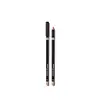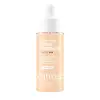The Saem Cover Perfection Concealer Pencil Versus Neutrogena Sensitive Skin Serum Foundation with Moisturizing Vitamin-B5
What's inside
What's inside
 Key Ingredients
Key Ingredients

 Benefits
Benefits

 Concerns
Concerns

 Ingredients Side-by-side
Ingredients Side-by-side

Titanium Dioxide
Cosmetic ColorantHydrogenated Coco-Glycerides
EmollientRhus Succedanea Fruit Wax
Triethylhexanoin
MaskingDipentaerythrityl Hexahydroxystearate/Hexastearate/Hexarosinate
Skin ConditioningHydrogenated Castor Oil
EmollientPalmitic Acid
EmollientStearic Acid
CleansingSucrose Tetrastearate Triacetate
EmollientCI 77492
Cosmetic ColorantMicrocrystalline Wax
Emulsion StabilisingCI 77491
Cosmetic ColorantCI 77499
Cosmetic ColorantPhenoxyethanol
PreservativeButyrospermum Parkii Butter
Skin ConditioningSimmondsia Chinensis Seed Oil
EmollientTocopheryl Acetate
AntioxidantArgania Spinosa Kernel Oil
EmollientTitanium Dioxide, Hydrogenated Coco-Glycerides, Rhus Succedanea Fruit Wax, Triethylhexanoin, Dipentaerythrityl Hexahydroxystearate/Hexastearate/Hexarosinate, Hydrogenated Castor Oil, Palmitic Acid, Stearic Acid, Sucrose Tetrastearate Triacetate, CI 77492, Microcrystalline Wax, CI 77491, CI 77499, Phenoxyethanol, Butyrospermum Parkii Butter, Simmondsia Chinensis Seed Oil, Tocopheryl Acetate, Argania Spinosa Kernel Oil
Water
Skin ConditioningButylene Glycol Dicaprylate/Dicaprate
EmollientDimethicone
EmollientPhenyl Trimethicone
Skin ConditioningMethyl Trimethicone
Skin ConditioningGlycerin
HumectantLauryl PEG-10 Tris(Trimethylsiloxy)Silylethyl Dimethicone
EmulsifyingPentylene Glycol
Skin ConditioningOctyldodecyl Stearoyl Stearate
EmollientButylene Glycol
HumectantSodium Chloride
MaskingCetyl PEG/PPG-10/1 Dimethicone
EmulsifyingIsododecane
Emollient1,2-Hexanediol
Skin ConditioningPanthenol
Skin ConditioningTrimethylsiloxysilicate
EmollientDiphenylsiloxy Phenyl Trimethicone
Skin ConditioningPolymethylsilsesquioxane
Silica
AbrasiveDimethicone/Vinyl Dimethicone Crosspolymer
Skin ConditioningGlyceryl Caprylate
EmollientTribehenin
EmollientDisteardimonium Hectorite
StabilisingTriethoxycaprylylsilane
Disodium EDTA
Titanium Dioxide
Cosmetic ColorantIron Oxides
Mica
Cosmetic ColorantWater, Butylene Glycol Dicaprylate/Dicaprate, Dimethicone, Phenyl Trimethicone, Methyl Trimethicone, Glycerin, Lauryl PEG-10 Tris(Trimethylsiloxy)Silylethyl Dimethicone, Pentylene Glycol, Octyldodecyl Stearoyl Stearate, Butylene Glycol, Sodium Chloride, Cetyl PEG/PPG-10/1 Dimethicone, Isododecane, 1,2-Hexanediol, Panthenol, Trimethylsiloxysilicate, Diphenylsiloxy Phenyl Trimethicone, Polymethylsilsesquioxane, Silica, Dimethicone/Vinyl Dimethicone Crosspolymer, Glyceryl Caprylate, Tribehenin, Disteardimonium Hectorite, Triethoxycaprylylsilane, Disodium EDTA, Titanium Dioxide, Iron Oxides, Mica
Ingredients Explained
These ingredients are found in both products.
Ingredients higher up in an ingredient list are typically present in a larger amount.
Titanium dioxide is a mineral UV filter widely used in sunscreens and cosmetics.
It is one of only two UV filters officially classified as “mineral” by regulatory agencies, the other being zinc oxide.
Titanium dioxide provides broad-spectrum protection mostly in the UVB and UVAII range, with some protection in the UVAI range.
While its UVA protection isn’t as strong as zinc oxide’s, the difference is minor.
A common myth is that mineral UV filters reflect UV light. However, modern research shows titanium dioxide absorbs UV radiation like chemical filters (~95% absorption & 5% reflection).
Thanks to its non-irritating nature, titanium dioxide is suitable for sensitive, acne-prone, or redness-prone skin. It is unlikely to cause "eye sting" like other sunscreen ingredients.
A major drawback of this ingredient is its white cast and thick texture. This is why mineral sunscreens often leave a white cast and are less cosmetically elegant than chemical/hybrid sunscreens.
To improve white cast and spreadability, micronized or nano-sized titanium dioxide is often used.
There are ongoing concerns surrounding nano-titanium oxide's impact on marine ecosystems.
There is no conclusive evidence that any form of titanium oxide (or any other sunscreen ingredients) will cause harm to marine ecosystems or coral reefs. The science is still developing but many consumers are keeping a close eye on this issue.
Please note, many destinations have reef-safety sunscreen rules. For instance, the U.S. Virgin Islands advises all visitors to use non-nano mineral sunscreens.
Nano mineral sunscreens once raised safety concerns about absorption into skin.
Extensive research has shown that they do not penetrate healthy or damaged skin; they remain safely on the surface and the top layer of dead skin (stratum corneum).
You'll likely find titanium dioxide bundled with alumina, silica, or dimethicone. These ingredients help make titanium dioxide highly photostable; this prevents it from interacting with other formula components under UV light.
Learn more about Titanium Dioxide